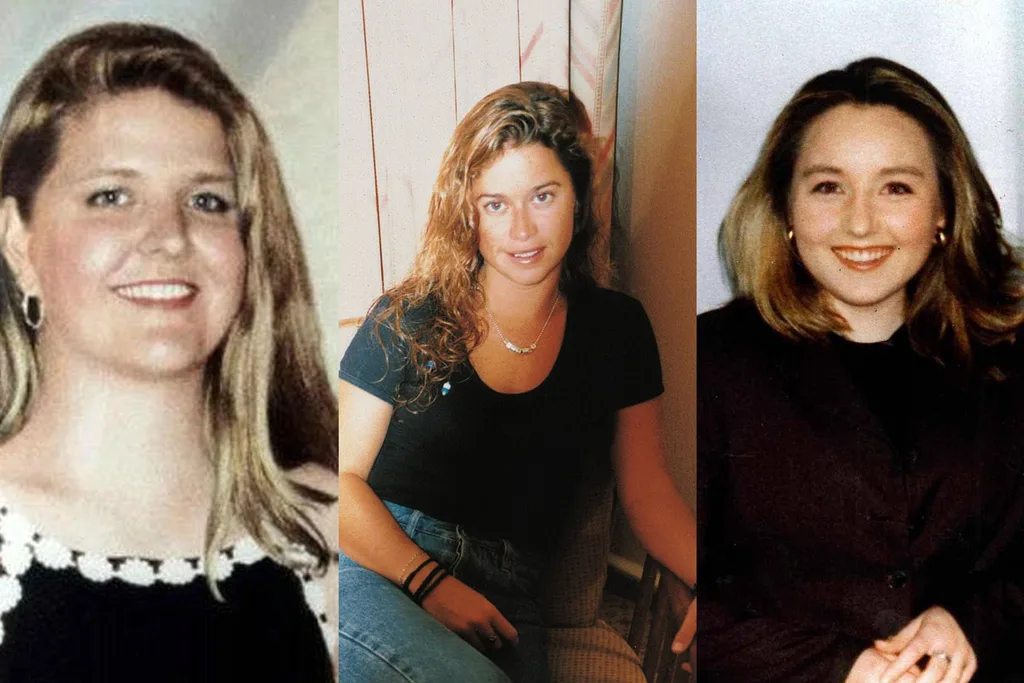When three young women were abducted and murdered in Perth during the ’90s, the unsolved crimes haunted the city for decades. Finally, following the most expensive police investigation in Australian history, the Claremont serial killer has been brought to justice. Those close to the case tell Michael Crooks their stories.
For 20 years, they were the unsolved crimes that devastated families, changed the way women went out at night and left a city in fear: three young women plucked from the streets and taken to their deaths.
It began with Sarah Spiers, an 18-year-old receptionist who disappeared on January 27, 1996, after a night out in Claremont. The wealthy riverside suburb had a thriving night scene that included the iconic Continental Hotel and Club Bayview, where Spiers was last seen. Her body has never been found.
Six months after that, childcare worker Jane Rimmer, 23, vanished following drinks at the Continental. Her body was found two months later in bushland 40 kilometres away.
Then, on March 15, 1997, after a night out at the Continental, lawyer Ciara Glennon, 27, was last seen interacting with someone in a car before going missing. A man stumbled across her body three weeks later in bushland 50 kilometres north of Perth. Both Rimmer’s and Glennon’s necks had evidence of injuries consistent with knife cuts, and they both bore defensive wounds on their arms.
The murders sent shockwaves through the city, but as the Claremont serial killer loomed large, police grappled to find a suspect.
Twenty years later, following a breakthrough from improved DNA testing, police announced on December 22, 2016, that they had made an arrest. The suspected killer was 48-year-old Bradley Robert Edwards.
The former Telstra technician, who had been married twice and volunteered at his stepdaughter’s Little Athletics club, was charged with the murders, as well as two other historical crimes: the attack on an 18-year-old at her home in 1988; and the rape and abduction of a girl, 17, in a Claremont cemetery in 1995. Edwards pleaded guilty to the two attacks, but denied he was a killer.
On September 24, after a judge-only trial that ran for seven months, Justice Stephen Hall found Edwards, now 51, guilty of murdering Jane Rimmer and Ciara Glennon. A lack of evidence meant Edwards was acquitted of Sarah Spiers’ murder, but Justice Hall said it was “likely” he was her killer. The verdict, at long last, brought justice for the victim’s families and those who lives were impacted.

The Best Friend: Sarah Wanek
When childcare worker Jane Rimmer didn’t turn up to a Sunday roast on June 9, 1996, her concerned mother began calling family and friends. Rimmer was a responsible, level-headed girl who never missed the weekend catch-up, which often included watching her beloved West Coast Eagles play football.
“I remember getting the call to say Jane was missing,” says Sarah Wanek, one of Rimmer’s closest friends. Now 47, the Perth-trained nurse lives in San Francisco with her husband, Don, and three children. “I thought it was ridiculous. I thought she’d probably stayed at a friend’s after having too much to drink. But then the police called me asking questions. That’s when it got real.”
Fifty-five agonising days later, Rimmer’s naked body was discovered by a woman picking wildflowers. Rimmer’s throat had been cut, and a Telstra-issued pocket knife was found near the scene. Several residents testified to hearing screams in the area on the evening Rimmer disappeared. One man heard a woman pleading, “Leave me alone, let me out of here.”
“It was traumatic,” says Wanek. “You watch TV shows about murders, but you just never think it’s going to happen to someone you know, in the city where you felt so safe. And it happened to a girl who was so lovely.” Rimmer and Wanek were inseparable as kids. Their mums, Jenny Rimmer and Lorraine Forman, were best friends, and the daughters also formed a tight bond. “Jane was a girly girl – she was full of life,” says Wanek.
And she adored children. “Jane was yearning for a family. She wanted to get married – she wanted to be loved and have kids to love.”
As police investigated the murder, Wanek was brought in to look at the CCTV footage from the night of her friend’s disappearance. Earlier that day, Rimmer had been to the hairdressers before having lunch with her mum. She met friends for drinks at the Continental, but by midnight, as the footage showed, she was alone outside the pub. The vision next revealed a dark-haired man approaching her. Rimmer smiled as if she expected him, appearing to know him. Wanek told detectives she didn’t recognise the man, and she now believes it might have been Edwards. “He just looks like every other guy,” says Wanek. “For someone like Jane, who wanted to find love, she’s easy prey. I can see her going willingly in his car.”
Not long after Rimmer’s funeral, Wanek went travelling overseas to escape from the trauma of her loss. She suffered panic attacks and anxiety. As the months rolled into years without an arrest, Wanek conducted her own investigation. “I just wanted to do something, anything,” she explains.
“I needed answers.”
Those answers finally came with Edwards’ conviction. An emotional Wanek says she is “relieved and elated with the verdict”, and is grateful to the many people who took part in the case. “I thank them from the bottom of my heart,’’ she says. “With any luck, Edwards will never be out in public again and [he will] endure a pain and existence he deserves. I believe Jane and Ciara can now finally rest in peace.’’

The Detective: Terry Dobson
Before he was assigned to the first of the Claremont serial killings cases, Detective Sergeant Terry Dobson was the lead investigator on Bradley Edwards’ first-known attack, when the future killer was just 19 years old.
On the night of February 14, 1988, the detective was called out to a family home in the working-class suburb of Huntingdale, where an 18-year-old had been attacked in her bed.
The woman awoke to find a man on top of her, his hand clasped over her mouth. Terrified, she dug her fingernails into the man’s cheek and he clambered off. When she turned, he was standing in her bedroom doorway, wearing what looked like a woman’s nightie. She screamed for her father and the man fled, leaving behind a silky white kimono.
“It was a strange attack,” recalls Dobson. “He had unplugged the telephone and closed the parents’ bedroom door. The kimono got our attention as you don’t often have things like that at a crime scene.”
On a hunch, a fellow detective suggested they use his mate’s tracker dogs to see if the kimono could be traced. The next day, two dogs followed the garment’s scent to a nearby house where a couple lived. Inside, police found a sash that belonged to the kimono.
After clearing the husband as a suspect, the detectives learnt the kimono had been stolen from the property. But despite a thorough investigation, the case went cold.
“I’d like to say Bradley Edwards was on our radar back then,” says Dobson, “but his name never came up.”
Dobson had been promoted to the Major Crime Squad when Sarah Spiers, a cherubic beauty from rural Western Australia who was living in South Perth with her older sister, disappeared while waiting for a taxi in Claremont. “Blood-curdling” screams were heard by residents in nearby Mosman Park on the night.
“My impression was that she was a good girl,” says Dobson. “If she wasn’t going to get home, she would always let her sister know. It just seemed she had been plucked off the street.”
The next week, Dobson took a call from a local detective who believed he had a related case from the year before. A 17-year-old girl had been brutally raped in Karrakatta Cemetery after being abducted from a Claremont park. Says Dobson: “I recall thinking, ‘This is him.’”
But it would take many years and two more killings for forensics to prove Dobson right. Until 2008, all the detectives had to link the crimes was a blue polyester fibre from a pair of Telstra trousers found on the bodies of Rimmer and Glennon, as well as the 17-year-old survivor.
Then in 2008, a specialised UK lab made a stunning breakthrough. They found DNA from an unknown male in a sample taken from under Glennon’s fingernails that, when it was run through the Western Australia database, matched samples taken from the survivor of the cemetery attack. In 2016, as part of a review of local cold cases, the kimono from the 1988 attack was retested. On it, scientists found sperm stains that also matched the still-unknown male’s DNA.
Detectives didn’t know their suspect’s name, but they knew from the kimono that he had been prowling the area stealing women’s clothes, and they had a fingerprint taken from the doorknob of one of those properties. When it was analysed, investigators were stunned to find it matched Edwards’. His fingerprints were on file because he’d been convicted of assaulting a social worker in a hospital in 1990 while there to repair phone lines. Convinced the killer was in their grasp, police began tracking Edwards and collected DNA from a Sprite bottle he had discarded while at the movies with his stepdaughter. It was a match.
“I felt overwhelming happiness for the families,” Dobson, now a high-profile defence lawyer, says of the arrest. “And also happiness for all the detectives and the prosecution. When I heard about Edwards being charged, I thought, ‘What if that detective who suggested using the dogs wasn’t there that day?’ You just think about all that stuff – those sliding doors moments.”

The Reporter: Alison Fan
The shocking disappearance of a third young woman from Claremont sparked a palpable sense of fear in Perth, veteran Seven Network reporter Alison Fan recalls. Following the disappearance of Sarah Spiers and the discovery of Jane Rimmer’s body, police suspected there was a serial killer at large. When Glennon vanished, there was no longer any doubt. “It was the same area, the same type of girl, the same circumstances,” says Fan, now 75 and a grandmother of seven. “It sent shockwaves through the city. Everyone was thinking, ‘Serial killer.’”
Fan, one of Perth’s most recognisable reporters, has worked on the Claremont killings story from the day of Spiers’ disappearance. “Sarah was a responsible girl, this was not usual behaviour,” Fan says. “Claremont is a very affluent suburb where you thought nothing bad could ever happen, but these women got snatched off the street. From then on, women-only went out in groups. It completely changed Perth.”
The WA Police set up a task force called Macro, conducting what would become Australia’s most expensive investigation. The government offered a then-unprecedented $250,000 reward for information, and celebrities, including Perth-raised actors Isla Fisher and Lisa McCune, pleaded for people to come forward.
Meanwhile, a special taxi rank was set up in Claremont and Club Bayview put out its own reward and had its own bus to take women home.
The killings also affected Fan personally. The journalist lives in Claremont, and during the ’90s, her youngest son, Jason, was studying law at the University of Western Australia alongside Glennon. “You looked at everybody, especially at night,” she remembers. “My sons were both going out to the same venues as the victims. I was very concerned about their girlfriends. I remember getting up at 2am to pick them all up.”
Over the ensuing years, Fan remained on the case, marking anniversaries, interviewing family and friends. She also scored a rare interview with Lance Williams, the beleaguered public servant who was named as the police’s prime suspect in the often controversial investigation. Williams had been spotted relentlessly cruising Claremont and had offered a lift to an undercover female police officer in 1997. While police staked-out his home, he publicly maintained his innocence up until his death from cancer in 2018. “He said he [thought he] was saving the woman,” says Fan. “He lived long enough to know Edwards got arrested.”
Coming out of semi-retirement to cover the trial for Seven, Fan sat in court every day of what the local media dubbed the “trial of the century”, alongside those close to the victims.
Glennon’s father, Denis, attended most days. So, too, did Spiers’ parents, Don and Carol, and Rimmer’s siblings, Adam and Lee. Her father, Trevor, died in 2008; her mother, who has suffered a series of strokes, is in aged care.
Flanked by police, the survivors of the cemetery attack and the home invasion were also at the trial, which, over the course of seven months, included more than one million pages of evidence, heard from 200 witnesses and covered DNA and clothing fibre evidence for weeks.
The guilty verdict closed a grim chapter for the city and finally gave justice to the loved ones of the victims, but heartbreaking questions remain.
“It’s good to know the ending,” says Fan. “This particular crime changed the face of Perth. But I don’t believe in the word closure. The Spiers are still going through the terrible anguish of not knowing where she is. They’ve got no resolve at all.”
This article originally appeared in the November 2020 issue of marie claire Australia.










